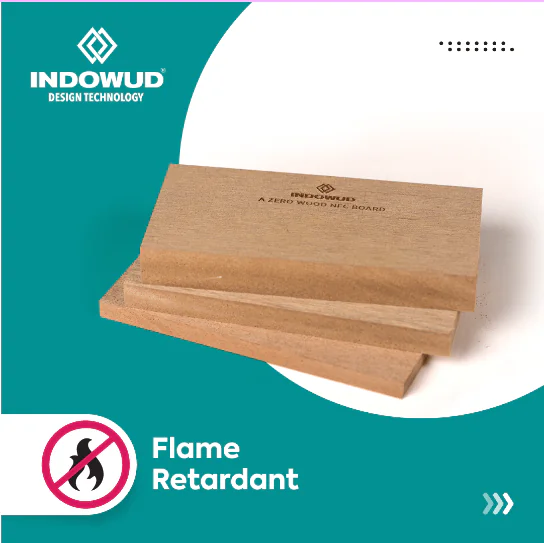Indowud NFC: Offering Fire Safe Solutions for Your Homes

Revolutionizing Fire Safety: The Future of Fire Retardant Boards
In today’s world, where fire safety is a top priority, traditional fire retardant Plywood are proving to be inadequate. These boards typically rely on chemical treatments to provide resistance against fire, ignition, and flame spread.
While these treatments may offer initial protection, they often deteriorate over time, causing the boards to lose their fire-resistant properties and become flammable once again. This presents a significant risk, especially in settings where long-term fire safety is crucial. There is an increasing need for a more reliable and durable solution—one that doesn’t just temporarily address fire risks but provides lasting Fire resistance.
Fire Resistant Boards vs. Fire Retardant Insulation Boards
When choosing fire safety materials, consumers are often faced with a dilemma between fire resistance boards and fire retardant insulation boards. Fire resistant boards are designed to slow down the spread of flames, providing additional time to evacuate or extinguish the fire.
On the other hand, fire retardant insulation boards offer enhanced thermal protection, helping to prevent the fire from spreading and affecting other areas. However, both of these options have their limitations, and neither provides a comprehensive solution.
This is where Indowud comes into play. Indowud nfc is a revolutionary product that combines the best features of both fire resistant and fire retardant insulation boards into one superior solution. It offers the flame-retardant properties of fire-resistant boards and the thermal insulation of fire retardant boards, making it the ideal choice for comprehensive fire protection.
Indowud nfc’s Game-Changing Feature
One of the standout features of Indowud nfc is its self-extinguishing capability. Unlike conventional fire resistance, which merely resist flames, Indowud nfc takes fire protection to the next level by actively stopping the spread of flames.
When exposed to fire, Indowud nfc doesn’t just slow down the flames; it extinguishes them. Once the ignition source is removed, the material ceases to burn, offering an unparalleled level of safety and peace of mind. This makes Indowud nfc an ideal choice for any application where fire protection is a top concern.
Smoke: The Silent Killer
While much emphasis is placed on the flame-resistant properties of fire retardant boards, the dangers of toxic smoke are often overlooked. Smoke inhalation is the leading cause of death in fire incidents, accounting for more fatalities than the flames themselves.
Many traditional fire retardant boards, despite adhering to IS 5509-2000 standards, still pose significant risks due to the toxic smoke they generate when they burn. This invisible threat can be just as, if not more, dangerous than the fire itself, making it essential to choose materials that minimize smoke emission.
The Health-Conscious Choice
Indowud nfc is not just another fire-resistant material—it’s a health-conscious choice. In rigorous fire tests, Indowud nfc has consistently demonstrated lower levels of smoke emission compared to traditional fire retardant boards. This makes it an ideal solution for environments where health and safety are of utmost importance, such as hospitals, hotels, schools, and residential buildings.
By opting for Indowud nfc, you’re not only ensuring fire resistant Board but also reducing the risk of smoke-related injuries and fatalities.
Unmatched Fire Safety Standards
Indowud nfc has undergone extensive testing to meet and exceed the most stringent international fire safety standards. The product has achieved a Class 1/A rating for low flammability, as classified by the International Maritime Organization (IMO), making it a preferred choice for marine applications, including yachts, boats, and shipbuilding.
Additionally, Indowud nfc holds a V0 rating in the UL 94 flammability test, which means it stops burning within 10 seconds of flame exposure. This significantly reduces the risk of flame spread and further enhances the safety of any environment where Indowud nfc is used.
Indowud nfc’s Performance in Key Fire Safety Tests
Indowud nfc has been rigorously tested against some of the most stringent fire safety standards in the industry. It has passed the UIC564-2 test, which is related to fire protection and firefighting measures in passenger-carrying railway vehicles. In this test, the specimen is exposed to a gas flame directed onto its surface, and Indowud nfc’s performance was exemplary.
Moreover, in the ASTM E84 test, which assesses the surface burning characteristics of building products, Indowud nfc achieved a Flame Spread Index of 6, placing it firmly in the Class A category. This makes Indowud nfc one of the safest and most reliable materials available on the market.
Value Beyond Compare
While the initial cost of Indowud NFC may be on par with traditional fire retardant Plywood, its long-term value is unmatched. Unlike other fire retardant materials that may degrade over time, losing their protective properties, Indowud NFC maintains its fire-resistant qualities throughout its lifespan. This means you won’t have to worry about the material becoming a fire hazard as it ages.
With superior performance in key areas such as flame spread index, smoke development index, and overall flammability, Indowud NFC offers a level of reliability that makes it a worthwhile investment for any application.
Why Indowud nfc is the Future
Indowud NFC is more than just a fire retardant plywood—it’s the future of fire protection. By combining advanced fire resistance, low smoke emission, and long-term durability, Indowud NFC sets a new standard in safety and reliability. Whether you’re looking for fire protection in residential, commercial, or marine applications, Indowud NFC delivers unmatched performance and peace of mind.
In today’s world, where fire safety is a top priority, traditional fire retardant boards are proving to be inadequate. These boards typically rely on chemical treatments to provide resistance against fire, ignition, and flame spread.
While these treatments may offer initial protection, they often deteriorate over time, causing the boards to lose their fire-resistant properties and become flammable once again. This presents a significant risk, especially in settings where long-term fire safety is crucial. There is an increasing need for a more reliable and durable solution—one that doesn’t just temporarily address fire risks but provides lasting resistance.
